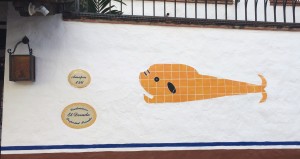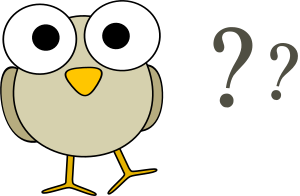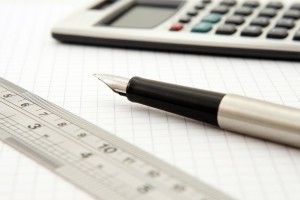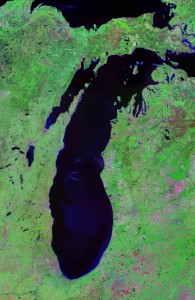A Fish Story
 I’ve said this before, but mathematics occurs in the strangest of places. Walking down the street in Puerto Vallarta, Mexico, I was admiring the architecture. Lo and behold, suddenly there appeared a tile mosaic of a fish on the side of one building. I’m such a math nerd, so I couldn’t help but notice the square tiles and wonder, how many tiles did it take to make that fish? Or in math speak, “what is the area of the fish?”
I’ve said this before, but mathematics occurs in the strangest of places. Walking down the street in Puerto Vallarta, Mexico, I was admiring the architecture. Lo and behold, suddenly there appeared a tile mosaic of a fish on the side of one building. I’m such a math nerd, so I couldn’t help but notice the square tiles and wonder, how many tiles did it take to make that fish? Or in math speak, “what is the area of the fish?”
Then the teacher in me emerged. I’ve been on a kick lately with the “What do you notice? What do you wonder?” strategy, mostly because it pulls kids in and draws forth their innate curiosity about the world around them. But also because it gets them thinking about how mathematics really can describe the world around them.
How Big Was the Fish?
I come from a fishing family. I remember early on my grandfather teaching me how to bait my own hook with a minnow so that we could allegedly go fishing near Lake Conroe. I don’t remember catching any fish, but I do remember spending the day with Grandpa. My dad took me fishing as well. If you spend enough time on a boat on a lake, you eventually get several stories about the fish that got away. After a few tellings, you end up having spotted the Loch Ness monster in the middle of Lake Livingston.
If you as a teacher showed the picture of the tile mosaic fish to 3rd or 4th grade students, what would you ask them to do with it? What would they notice or what would they wonder?
Pretty soon, someone is likely to wonder how big the fish is. At that point, measurement comes into the discussion. Students may wonder how long the fish is, how tall the fish is, or how many tiles it takes to make the fish. An 8- or 9-year-old probably isn’t going to talk dimensions or area, but they’ll get the idea if you let them fish around (pardon the pun) with it.
Selecting Tools for Area or Perimeter
No matter what state you teach math in, one of your process standards calls for students to be able to select and use appropriate tools to do mathematics. If your students want to know how big the fish is, they will need to think about some of the following questions.
What dimension (length, width) or attribute (area) do you need to measure?
 If you’re teaching a unit about area, students start with counting squares required to cover a particular surface. If you’re the craftsman who laid that fish into the stucco on the side of the building, you needed to know the answer to the question, “how many yellow tiles will it take to make the fish?” So that’s a good place to start. The size of each square tile may or may not be important. What is important is the number of square tiles (units, if you will) it takes to completely cover the fish. And that, my friends, is what area really is. Area isn’t “length times width” – that’s a procedure to calculate the area of a rectangle. Conceptually, area is the amount of flat space an object covers. In this case, that object is a fish.
If you’re teaching a unit about area, students start with counting squares required to cover a particular surface. If you’re the craftsman who laid that fish into the stucco on the side of the building, you needed to know the answer to the question, “how many yellow tiles will it take to make the fish?” So that’s a good place to start. The size of each square tile may or may not be important. What is important is the number of square tiles (units, if you will) it takes to completely cover the fish. And that, my friends, is what area really is. Area isn’t “length times width” – that’s a procedure to calculate the area of a rectangle. Conceptually, area is the amount of flat space an object covers. In this case, that object is a fish.
What tools would you use to measure it?

Measurement tools vary depending on the age of the students. In Grades K-2, attributes of objects are thought about with non-standard units of measure bridging into standard units of measure. By Grade 3, students are ready to think about area as the amount of space an object covers. Square units are the way we can count the area of an object.
Tools that are appropriate for thinking about area, especially an irregular figure such as the fish, may include color tiles or grid paper. Students can use color tiles to reconstruct most of the fish, but will realize pretty quickly that the tiles along the outside of the fish would need to be cut. A craftsman can use a tilesaw to do that, but you probably don’t want your students cutting up your color tiles. Paper squares are a possibility for a concrete manipulative. Grid paper is also appropriate. Students can draw the fish and shade, color, or count the tiles inside the fish.
I teach middle school. What’s in this problem for me?
Good question. Once students begin middle school, area formulas for shapes that are not rectangles or triangles become part of the content. In Texas, students in 6th grade learn and apply these formulas (6.8D) and students in 7th grade solve problems involving the area of composite figures (7.9C). Middle school students also learn about unit rates and proportionality, so once they know the area of the fish, then they can think about the cost of the tiles and estimate the cost of materials required to build the fish.
Work backwards. If you have 40 tiles, what other shapes could you build to go on the building next door?
What are some other problems like this one?
 The possibilities are limitless. Is there a park, museum, or zoo near you? If so, then they likely have tile arrangements either on the ground or on a wall. Make a visit and snap a picture with your smart phone. Or, visit their website and see what images are available. For older students, ask them to look around their neighborhoods and see what they can find. Community centers, neighborhood or apartment complex swimming pools, and other places around kids hold a surprising amount of mathematics.
The possibilities are limitless. Is there a park, museum, or zoo near you? If so, then they likely have tile arrangements either on the ground or on a wall. Make a visit and snap a picture with your smart phone. Or, visit their website and see what images are available. For older students, ask them to look around their neighborhoods and see what they can find. Community centers, neighborhood or apartment complex swimming pools, and other places around kids hold a surprising amount of mathematics.
If you’re a map junkie like I am, the sky is the limit here. What is the area of Lake Michigan? Give the students a map or a picture with a scale, a few tools from which to choose for their measurements, and let them go. When I taught high school Geometry, I used rulers, string, and centimeter grid paper copied onto transparencies. Give students a map of all five Great Lakes – or geographic features near you – and let them decide which one to measure and estimate the area. Extend the activity by asking about the length of shoreline (perimeter). Verify the results with a web search.
Maps are easily available from a state department of transportation, chamber of commerce, or convention and visitors’ bureau. You can usually obtain a class set of maps just by asking.
